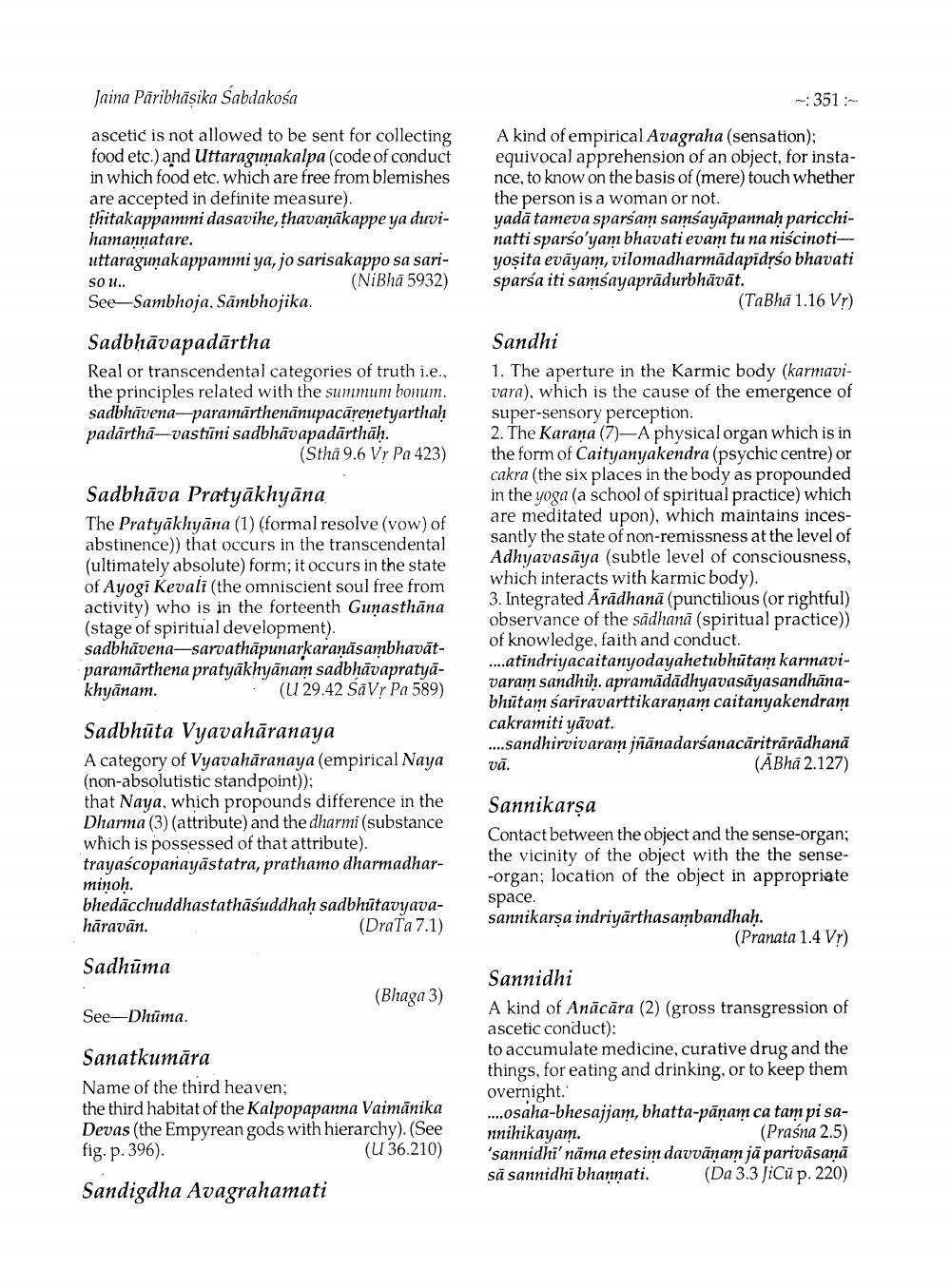________________
Jaina Pāribhāsika Sabdakosa
-351 -
ascetic is not allowed to be sent for collecting food etc.) and Uttaragunakalpa (code of conduct in which food etc. which are free from blemishes are accepted in definite measure). thitakappammi dasavihe, thavanākappe ya duvihamannatare. uttaragunakappammi ya, jo sarisakappo sa sariSO u..
(Nibha 5932) See—Sambhoja, Sāmbhojika.
A kind of empirical Avagraha (sensation); equivocal apprehension of an object, for instance, to know on the basis of (mere) touch whether the person is a woman or not. yadā tameva sparsam samsayāpannah paricchinatti sparso'yam bhavati evam tu na niścinotiyosita evāyam, vilomadharmādapidsso bhavati sparsa iti samsayaprādurbhāvāt.
(Tabhā 1.16 Vr)
Sadbhāvapadārtha Real or transcendental categories of truth i.e., the principles related with the summum bonum. sadbhāvena-paramārthenānupacārenetyarthah padārtha---vastuīni sadbhāvapadārthāh.
(Stha 9.6 Vr Pa 423)
Sadbhāva Pratyākhyāna The Pratyākhyāna (1) (formal resolve (vow) of abstinence)) that occurs in the transcendental (ultimately absolute) form; it occurs in the state of Ayogi Kevali (the omniscient soul free from activity) who is in the forteenth Gunasthāna (stage of spiritual development). sadbhāvena-sarvathāpunarkaraṇāsambhavātparamarthena pratyākhyānam sadbhävapratyakhyānam.
(U 29.42 SãVr Pa 589)
Sandhi 1. The aperture in the Karmic body (karmavivara), which is the cause of the emergence of super-sensory perception. 2. The Karana (7)-A physical organ which is in the form of Caityanyakendra (psychic centre) or cakra (the six places in the body as propounded in the yoga (a school of spiritual practice) which are meditated upon), which maintains incessantly the state of non-remissness at the level of Adhyavasāya (subtle level of consciousness, which interacts with karmic body). 3. Integrated Arādhanā (punctilious (or rightful) observance of the sādhanā (spiritual practice)) of knowledge, faith and conduct. ....atindriyacaitanyodayahetubhūtam karmavivaram sandhiḥ. apramādādhyavasāyasandhānabhūtam sariravarttikaraṇam caitanyakendram cakramiti yāvat. ....sandhirvivaram jñānadarśanacāritrārādhanā vā.
(ĀBhā 2.127)
Sadbhūta Vyavahāranaya A category of Vyavahāranaya (empirical Naya (non-absolutistic standpoint)); that Naya, which propounds difference in the Dharma (3) (attribute) and the dharmi (substance which is possessed of that attribute). trayascopanayāstatra, prathamo dharmadharminoh. bhedacchuddhastathāśuddhah sadbhutavyavahāravān.
(DraTa 7.1)
Sannikarsa Contact between the object and the sense-organ; the vicinity of the object with the the sense-organ; location of the object in appropriate space. sannikarsa indriyārthasambandhaḥ.
(Pranata 1.4 Vr)
Sadhūma
(Bhaga 3)
See-Dhüma.
Sanatkumāra Name of the third heaven; the third habitat of the Kalpopapanna Vaimānika Devas (the Empyrean gods with hierarchy). (See fig. p. 396).
(U 36.210)
Sannidhi A kind of Anācāra (2) (gross transgression of ascetic conduct); to accumulate medicine, curative drug and the things, for eating and drinking, or to keep them overnight. ....osaha-bhesajjam, bhatta-pāņam ca tam pi sannihikayam.
(Praśna 2.5) 'sannidhi'nāma etesim davvānam jā parivāsanā sā sannidhi bhannati. (Da 3.3 JiCüp. 220)
Sandigdha Avagrahamati




